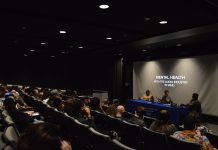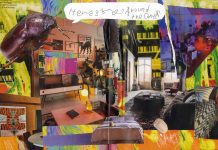A.D. Coleman has worked for 50 years as a photography critic, but he said he was never interested in becoming a photographer himself. As the first photo critic for the New York Times, Coleman said he believes he has an advantage over critics with photography experience.
“If you are also a critic and a performer, you’re most likely to favor the work that’s in your territory and take less seriously the areas you have set aside,” Coleman said. “Whereas a non-performer like myself is more likely to just take a broad overview of all the different things that people are working on in that medium.”
Coleman spoke at Webster University on Nov. 9 about his research surrounding the myths of Robert Capa’s photographs on D-Day. His speech opened a one month long exhibit of Capa’s photography in the May Gallery entitled “Alternate History: Robert Capa on D-Day”.
Capa was a war photographer on assignment at D-Day, the day Allied forces invaded the beaches of Normandy, France, during World War II. According to Capa, a malfunction in the darkroom while his photos were being processed resulted in only 11 photos saved and published in Life Magazine. Coleman, along with a team of researchers, questioned how Capa’s prints were destroyed and began to research the topic four and a half years ago.
“No one with darkroom experience would come up with this notion,” Coleman said. “Only someone entirely ignorant of photographic materials and processes.”
Coleman and his team theorized instead that Capa only shot the amount of photos processed. Coleman said there was no processing malfunction because there were no more photos taken to begin with. When his photo editor at Life Magazine realized this, Coleman said he probably invented a story in order to save both his and Capa’s careers.
Bill Barrett is a professor at Webster and the director of the May Gallery. Barrett said he has known Coleman since the 1970s and considers him a friend.
“I think he is one of the smartest people writing about photography today,” Barrett said. “Just to bounce ideas off him and ask him his thoughts on different things is really terrific.”
Barrett said he has followed Coleman’s research on Capa from the beginning. He said he hopes people who attended Coleman’s talk on the subject realized they should challenge assumptions they make based on what they are told by other people.
Coleman said he feels his work is important to share with students because it is important for them to question the history of photography.
“Our job as teachers is to teach students to think critically and not simply to accept standard narratives but to ask are there other ways of thinking about this or seeing this situation?” Coleman said.
Carolynne Barrow is a photography major and a student in Barrett’s photo gallery management class. She said she felt Coleman’s research carried impact because it is important to know the truth about the history of photojournalism.
“It was told so many times that it became the truth,” Barrow said. “It’s really cool to be like, ‘Hey, this is what everyone accepts as the truth, but it’s not true.’”
Coleman said photo criticism and history is a recent subject, having only been around for 50 years. He said because of this, there is a lot of work that should be investigated but has not yet.
Barrow said she thinks there are other instances in photography history where the ethics of a photographer can be looked into. She said part of her studies include looking at photos that were staged.
“There’s a lot of older pictures where the ethics of the photograph itself, or the truthfulness of the photograph itself, are questionable or don’t necessarily tell the entire story,” Barrow said.
Coleman said his research into the subject is not done. He said he is waiting on access to archives that will further prove his research that Capa only shot the amount of photos that were processed.
Coleman and his research team received two awards for their work from the Society of Professional Journalists (SPJ). They received both the Delta Chi Award for Research About Journalism in 2014 and the Photo Review Award in 2015. Coleman said winning awards from SPJ validated the work they had been doing.
“It was heartening in that we had made this contribution and peers and colleagues in journalism broadly saw the value of that contribution,” Coleman said.



